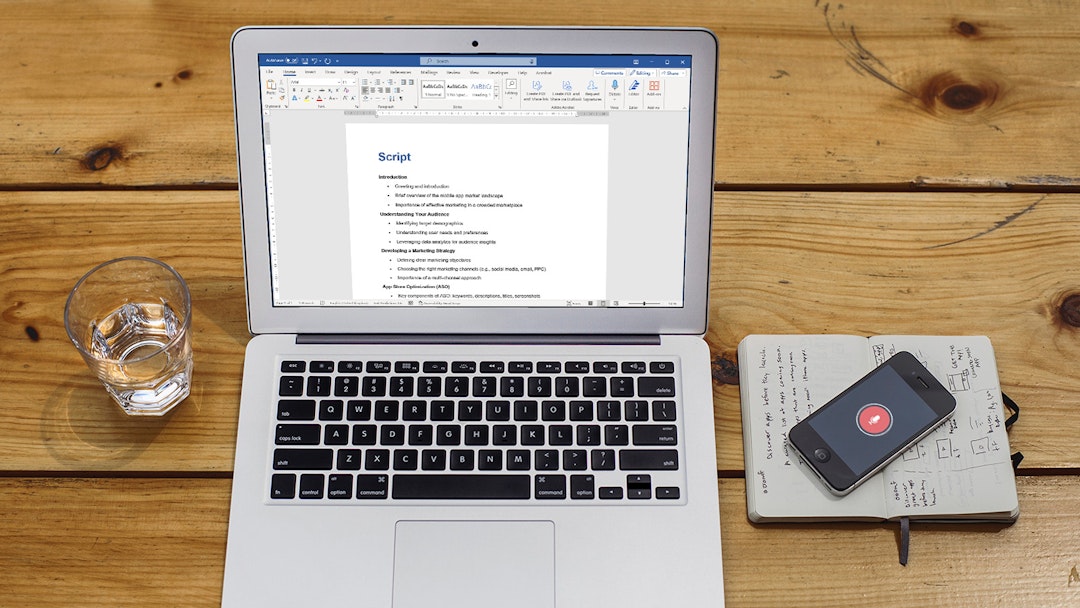A small amount of extra effort goes a long way when it comes to DIY audio recordings. Poor recordings are distracting and hinder your message.
If you need to record your voice, these practical tips will help you create a more professional audio track that communicates more clearly, leaves a better impression, and is more enjoyable to listen to.
You need to consider:
- Environment: Find a quiet, low-echo space
- Microphone: Keep it still and leave it alone
- Performance: Practise; be clear and confident
There’s a lot more to it though, so read on for all the details.
Environment

You need to record in an environment that’s as quiet and free from echo as possible.
If your recording device is portable, move to the best location. If recording at home, your bedroom is probably best – there are no noisy fridges or computer fans (but watch out for creaky beds), and the soft furnishings will dampen echoes. If recording in an office, an enclosed meeting room is probably best. Smaller rooms have less echo.
Pick a quiet time: probably mid-morning or mid-afternoon, when there may be less traffic and people are busy working. If you’re not alone, ask others to be on their tiptoes until you give the all clear.
Eliminate any sources of noise that you can control. For instance, air conditioners and even distant washing machines will produce a rhythmic drone. To minimise noises you can’t control, shut all the doors and windows you can – not just the ones in the room where you’re recording.
Microphone

Avoid using your computer’s built-in mic, which will be low quality and will pick up the hum of the computer itself. Your smartphone has a better mic, it’s portable, and its internal electronics are silent.
If you expect to be recording regularly (even twice a year), it’s worth investing in a separate, high-quality microphone and/or portable recording device. From around £100/$100, you will get a big jump in recording quality.1
Place the microphone, or place yourself, so that your mouth is just above the level of the mic, 6-12 inches away. The mic should be angled towards you, but don’t speak directly into it – direct your voice just over the top.
Whatever you use, place the mic somewhere stable and leave it alone. Even handling the mic or touching a cable can create shuffling sounds. A tripod or stand may be a worthwhile investment.
Finally, always do a short test recording and listen to it (with headphones if possible). Eliminate any technical issues now, before you waste time on the real recording.
Performance

Practise
Plan what you’re going to say, ideally in a fully written script, and practise. Check how you sound, and consider how to adjust your words or performance.
Prop any notes up in front of you. Don’t hold any papers: the mic will pick up the sound of them in your hands. For multi-page notes, ideally, print them one-sided and spread them all out in advance.
Prepare your voice
To sound at your best, you need to be well hydated and all your airways need to be clear. So, drink some water (and keep a glass with you) and blow your nose!
You should also warm up your voice if you haven’t been speaking much in the last hour. Sing a quick song (but no belting ballads that will leave you hoarse).
Stay still!
For audio recordings, we don’t want a whole-body performance. If you move about (shuffle, gesticulate, etc.) this can create rustling sounds (from your clothing, chair, etc.) that are distracting in the recording and can be hard to remove later.
Recording in a group
If you’re recording in a group, appoint one person as the Director. This person should pay attention to everyone’s delivery, helping all performers to match each other’s volume and pace.
When you’re not speaking, remember to keep absolutely still and quiet. Any coughs or rustling could spoil the recording.
Delivery

A good delivery is clear and confident. But what does that mean?
To sound clear, enunciate all your words. In normal speech, we often mash words together (e.g., “I wen-a-th shop” instead of “I went to the shop”). For a clear recording, you need to speak more slowly and clearly than you normally would. For the right volume, speak as if you were talking to someone across a large table.
To sound confident, don’t be in a rush. Breath naturally and take pauses. Practice will also help reduce filler sounds (“umm”, “uh”, “y’know”) that can make people sound unsure. A composed posture will also enhance your voice.
What you’re saying almost certainly has an emotional element; so, feel the emotion you want to convey! If you’re smiling while you speak, that happiness will shine through in the subtle nuances of your voice.
Summary
- Find the quietest room with no echo
- Close all doors and windows
- Use the best mic you can get
- Keep the mic stable and leave it alone
- Speak from 6-12 inches away
- Direct your voice just over the mic
- Use a script, and practise it
- Hydrate and warm up your voice
- Speak more slowly and enunciate
- Don’t rush: pause and breathe
- Feel the emotion you want to convey
- Always do a test recording
-
Ensure you also acquire a windshield if one isn’t included – even a cheap foam covering will reduce distracting breathing sounds. You don’t need a pop shield though – the difference these make is almost inaudible. ↩
If this was useful, let us know your thoughts over on:
While you're there, drop a Like or Share if this was useful so we know to write more like it in future.
Anyone whose primary business is professional recording is tearing their hair out by this point! And they’re right: for truly crisp and clear sound, you need high-end equipment and an experienced team. There is no alternative.
But if you don’t have the budget for that, these tips will help you achieve the best recording possible, making a dramatically audible difference that will help get your message through.

 LinkedIn
LinkedIn
 Facebook
Facebook
 Twitter
Twitter
 Medium
Medium